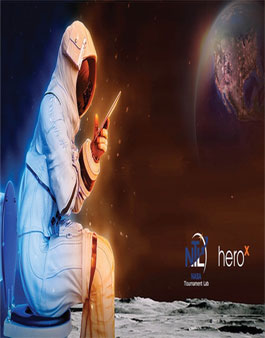공모전 대외활동 정보
NASA’s Lunar Loo Challenge - Junior Category
조회수 : 3,090
- 분야
- 응모대상
- 주최/주관 Artemis
- 후원/협찬
- 접수기간 2020-06-26 ~ 2020-08-17 D+1,341
- 총 상금 다양한 혜택
- 1등 상금
- 홈페이지 https://www.herox.com/LunarLooJr/guidelines
- 첨부파일 파일없음
상세내용
※ 본 내용은 참고 자료입니다. 반드시 주최사 홈페이지의 일정 및 상세 내용을 확인하세요.
NASA’s Lunar Loo Challenge - Junior Category
Challenge Overview
This challenge is for anyone under the age of 18. If you are 18 years of age or older, please go here.
If you are 12 years old or younger, please have your parent/guardian register on your behalf.
We are going back to the Moon.
Artemis is NASA’s program to land the first woman and the next man on the Moon by 2024. Humanity is going back to the Moon to establish a presence that will enable eventual crewed journeys to Mars. As we prepare for our return to the Moon, innumerable activities to equip, shelter, and otherwise support future astronauts are underway. These astronauts will be eating and drinking, and subsequently urinating and defecating in microgravity and lunar gravity. While astronauts are in the cabin and out of their spacesuits, they will need a toilet that has all the same capabilities as ones here on Earth.
NASA is calling on the global community for their novel design concepts for compact toilets that can operate in both microgravity and lunar gravity. These designs may be adapted for use in the Artemis lunar landers that take us back to the Moon. Although space toilets already exist and are in use (at the International Space Station, for example), they are designed for microgravity only. NASA is looking for a next-generation device that is smaller, more efficient, and capable of working in both microgravity and lunar gravity. Getting back to the Moon by 2024 is an ambitious goal, and NASA is already working on approaches to miniaturize and streamline the existing toilets. But they are also inviting ideas from the global community, knowing that they will approach the problem with a mindset different from traditional aerospace engineering. This challenge hopes to attract radically new and different approaches to the problem of human waste capture and containment.
We want to encourage the next generation of space explorers, engineers, and scientists, and we know that students may think about this design problem without the same constraints as adults. So in addition to the main Technical category, this challenge will have a Junior category.
The goal of this category is to get our younger participants excited and thinking about STEM projects, and specifically about lunar toilets. If you are 15 or over and believe that you have an idea with technical merit, we encourage you to have your parent or guardian submit your design concept on your behalf in the main Technical category.
To submit to the Junior category, you must be less than 18. If you are younger than 12 years old, you must have a parent register and submit on your behalf.
The top three participants in the Junior category will each receive public recognition and an item of official NASA-logoed merchandise.
■ Background
With the Artemis program, NASA will land the first woman and the next man on the Moon in 2024, and the goal is to do this in a way that uses less mass, occupies less volume, is more energy efficient, and has streamlined processes. This massive effort is able to stay on track thanks to intensive collaboration between NASA and its commercial partners. These partners are designing and developing different elements that are part of the overall program, including lunar landers and rovers. Toilets will be integrated into landers developed by commercial partners. Due to the parallel development of components, the exact dimensions and performance specifications of lunar toilets are still unknown. Nonetheless, there are general specifications and constraints for these toilets, and they are discussed below. Designing and developing new lunar toilets may not be as exciting or intriguing as developing tools to support the exploration of the lunar surface, but the need is just as important.
Lunar toilet design concepts should allow astronauts to urinate and defecate in both microgravity and lunar gravity. Microgravity is what is generally considered “zero-g” and is experienced as weightlessness. The g-force is not actually zero in microgravity; it is just very small. Lunar gravity is approximately one sixth of Earth’s gravity, so urine and feces will fall down.
The process for using proposed toilet designs must be relatively straightforward. Anything that is very time intensive or complicated to use will generally be less attractive to NASA. Toilets will operate in a nominal spacecraft environment with an air pressure of 14.7 psia (sea level like on Earth) or 8.2 psia, and the toilet storage systems could experience 0 psia (vacuum) during Extra-Vehicular Activities (EVA). Additionally, toilet designs should conserve water and help maintain a pristine environment inside the lander that is free of odors and other contaminants. Complete solutions will be ones that can support a crew of two astronauts for 14 days, while controlling odor, accommodating different types of waste (urine, feces, vomit, diarrhea, menses), and different gender users (female and male).
Additionally, toilet designs must be able to accommodate sick crew members dealing with vomiting and diarrhea. Although the preferred method for capturing vomit will be emesis bags (“throw up” bags), bonus points will be awarded to designs that can capture vomit without requiring the crew member to put his/her head in the toilet.
■ Toilet Design Specifications
The specifications listed below represent the maximum allowed values. Proposed designs should at least meet them and will preferentially be lower than them. The toilet design should:
Function in both microgravity and lunar gravity
Have a mass of less than 15 Kg in Earth’s gravity
Occupy a volume no greater than 0.12 m3
Consume less than 70 Watts of power
Operate with a noise level less than 60 decibels (no louder than an average bathroom fan)
Accommodate both female and male users
Accommodate users ranging from 58 to 77 inches tall and 107 to 290 lbs in weight
Toilet Performance Specifications
We are looking for a design that captures all the functionality of a toilet on Earth. At a minimum, crew using lunar toilets should not be exposed to vacuum during use, and toilet designs should be able to:
■ Accommodate simultaneous urination and defecation
Collect 1 liter of urine per use, with an average of 6 uses per crew per day
Accommodate 500g of fecal matter per defecation, with an average of 2 uses per crew per day
Accommodate 500g of diarrhea per event
Accommodate an average of 114g of female menses, per crew per day
Stabilize urine to avoid the generation of gas and particulates
Accommodate crew use of toilet hygiene products, like toilet paper, wipes, and gloves
Be clear of previous user’s urine and feces in preparation for the next use
Allow for transfer of collected waste to storage and/or provide for external vehicle disposal. Minimal Lander volume requires regularly minimizing waste storage or removing it from the vehicle
Allow for easy cleaning and maintenance, with 5 minute turnaround time or less between uses
Additionally, in the event of a system failure, the toilet designs will ensure that:
All waste materials collected remain safely stored
The crew is not exposed to urine, feces, or other collected materials
The crew is not exposed to vacuum
■ Prize
This challenge has two categories: Technical and Junior. Submissions to both categories are due no later than 5pm ET on August 17, 2020. The winners for the Technical category will be announced on September 30, and the winners for the Junior category will be announced on October 20, 2020.
In the Junior category, this challenge will recognize the top three submissions, one per age group. The authors of these three submissions will each receive: public recognition from NASA and from HeroX, a winner’s certificate, and an item of official NASA-logoed merchandise. Additional “mystery” prizes may also be awarded to winners of the Junior category. Such prizes could include a video call between the winner’s science class and an astronaut, or NASA-logoed specialty items (patches, pins, etc). To submit to this category, you must be less than 18 years of age.
- Category : Junior
* Ages 15-17, Ages 11-14, Under 11
- Award
* Certificate, Public recognition, Official NASA-logoed merchandise Additional “mystery” prizes!
■ Timeline
Open to submissions : June 25, 2020
Submission deadline : August 17, 2020 @ 5pm ET
Junior category judging and evaluation : August 18 - October 13, 2020
Junior category winners announced : October 20, 2020
본 정보의 사실 여부를 보증하지 않습니다.
반드시 주최사 홈페이지의 공모요강을 확인하시기 바랍니다.
반드시 주최사 홈페이지의 공모요강을 확인하시기 바랍니다.























